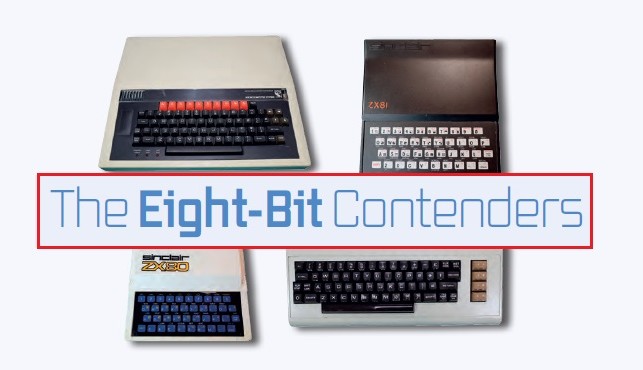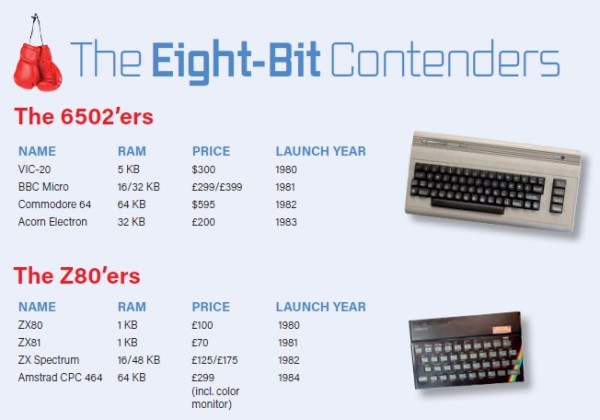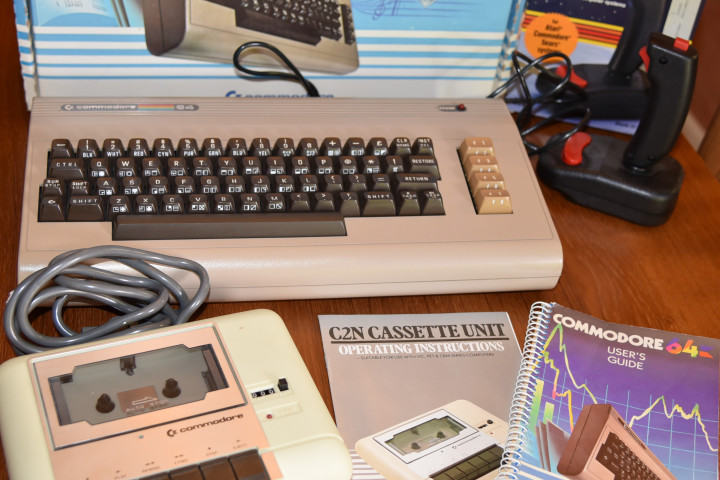The Battle of 8-Bit Home Computers
on

With a futuristic whiff lingering in the air thanks to NASA’s Space Shuttle, and the microprocessor an established element of the semiconductor industry, owning a computer in the 1980s became a possibility for the masses. The MITS Altair 8800 minicomputer, using Intel’s eight-bit 8080, had sold in its thousands since 1975 but, without a keyboard or monitor, it couldn’t be described as simple to program. At $439 for a self-build kit and $621 assembled, it wasn’t cheap either. That all changed with the launch of a home computer for under £100 ($137). Let's take a look at the history of home computers.
The 1980s: Early Home Computers
Entering the 1980s, three key computers were already on the market: the TRS-80, the Commodore PET, and the Apple II. While the first two machines would leave you with some change out of $1000, the Apple II came in at a whopping $1295. Their main advantage over machines such as the Altair 8800 was their keyboard, monitor (or support for a TV), and — the killer feature — BASIC. Rather than struggle with assembly programming and develop an understanding of microprocessor internals, users could create programs using simple, understandable commands.

ZX80/ZX81
In May 1979, the UK’s Financial Times predicted that a ‘user-friendly computer’ with keyboard and display for less than £100 would be on the market within five years. Sir Clive Sinclair and what was to become Sinclair Research Ltd. decided to make that future a reality, albeit a little faster. By February of 1980, the ZX80 was launched for £99.95 or £79.95 if you were prepared to build it yourself. Based upon Zilog’s Z80, the processor developed by Federico Faggin after leaving Intel, it featured 1 KB of memory that could be upgraded to 16 KB. The input device stretched the definition of a keyboard somewhat, being only a flat membrane panel to save money. Each key press caused the display to flicker, something many commented was annoying but was sold as being ‘positive feedback’ to user input. There was no monitor included either. Instead, users had to hijack the family TV to get their computing fix.
Sinclair BASIC was created by John Grant of Nine Tiles, a consulting firm contracted to write the code. He assigned programming commands to individual keys, so pressing ‘O’ entered the ‘PRINT’ command, and ‘R’ was used to ‘RUN’ the program. Not only did this avoid mistakes, but it also reduced the amount of memory required to store programs. Although not ANSI-compatible, this version of BASIC fitted inside a 4 KB ROM alongside all the other code required to make the machine work. With minor tweaks to the software to support different TV standards, and thanks to its external power supply, the ZX80 also had some success abroad, and it spawned several clones.
The team responded rapidly to its success, bringing out the ZX81 in March of 1981. Assembled, this came in at £69.95 (£49.95 as a kit). The lower price resulted from design optimizations in the hardware and despite the larger ROM (8 KB) that allowed its BASIC to be improved. At under 18 cm on a side and retaining its membrane keyboard, it was robust enough to be carried to a friend’s house to code or play games in glorious black and white and without sound.
BBC Micro
The UK’s public service broadcaster, the BBC, had also decided to champion computer literacy. However, they felt that they would need a computer capable of running a standardized version of BASIC to ensure success. A tendering process led to the selection of Acorn Computers Ltd. for the development of the machine. They already had one computer on sale, the Acorn Atom (£170), based upon this era’s other alternative eight-bit processor, the 6502. Featuring a proper keyboard and integrated power supply, it looked similar to the machine that was to come: the BBC Micro.

Launched in the Christmas of 1981, the Model A, with 16 KB of RAM, was priced at £299. The 32 KB Model B would set you back £399 (Figure 1). Coupled with the BBC’s series of TV programs on computer literacy and government subsidies for computers, the BBC Micro made its way into schools and colleges across the UK. Despite its early tendency to overheat (due to the power supply), it proved highly successful. It offered a range of colors and graphics modes, offered three-tone generators plus noise for sound, and was highly expandable. Optional extras included co-processors (6502 or Z80), speech synthesis (TI TMS5200), and it even offered a networking interface, Econet. UK students may even recall taking floppy discs to lessons or typing up stories for the BBC Domesday Project that surveyed life in the UK in 1986, storing the results on laserdiscs.
The BBC Micro sold around 1.5 million units in total, and its very comprehensive BASIC implementation also included an in-built assembler. However, with competitors emerging both within the UK and abroad, its price was too high for many home-computing enthusiasts. The Acorn Electron, launched in 1983 for £200, provided the pedigree of the BBC Micro thanks to using the same BASIC. However, the 32 KB of memory was rapidly consumed by the higher graphics modes, leaving little over for programming. Competition in the home computing market had also become cut-throat, with comparable computing on offer for the same price or less. However, it did provide a cheap way to play Elite at home.
Commodore 64
By far the most successful home computer of the era was the Commodore 64. Often shortened to C64, it was also known as the “Brotkasten” (bread bin) in Germany (Figure 2). Commodore had already had success with its PET successor, the VIC-20 (VC-20 in Germany), and now owned a silicon design and fabrication plant thanks to their purchase of MOS Technology (MOS), the creators of the 6502 processor. Under the project name ‘VIC-40’, this new 6510-based machine (a 6502 derivative) was earmarked to have 64 KB of RAM from day one. It was clear that this would impact the final price but, with memory prices falling, this decision would work in Commodore’s favor over the almost 12-year life of this machine.

MOS had been working on video and sound chips for the video games industry. Known as VIC-II (Video Integrated Circuit) and SID (Sound Integrated Circuit), they allowed Commodore to produce many of the computer’s parts in-house. Entering the market at $595, it had dropped below $200 by 1985. Offering Commodore BASIC 2.0 created by Micro-Soft (later Microsoft), it offered users the ability to program and play a range of games. The sound made possible by the SID chip, thanks to its three independent oscillators and attack/decays/sustain/release volumes controls, enabled some impressive polyphonic audio tracks. The game Ghostbusters included Ray Parker Jr.’s dance-pop track in full, complete with a synthesized call-out of the game’s name if you pressed the spacebar.
While its disk drives were slower than the competition, some games and software could be executed directly from hardware cartridges. Simons’ BASIC was also popular, a version of BASIC that included improved support for creating graphics, thereby avoiding POKEing data directly into the VIC-II. It also offered users an insight into future graphical user interfaces with GeOS, where cursor control was provided by joystick as there were few mice available. By 1993, Commodore’s annual reports claimed to have sold 17 million of the machines.
Who Won? We All Did!
Without a doubt, readers will have memories of other significant 8-bit home computers, such as the Sinclair Spectrum or Amstrad CPC 464. Hours were spent typing in endless listings from magazines and books, coupled with referencing a myriad of code deviations to ensure the program worked on your machine. ZX81 users often had to make do with severely cut-down versions of programs due to the limited memory.
Regardless of the machine used, the home computing revolution of the 80s delivered us a generation of engineers, programmers, and games creators. Even Eben Upton, the inventor of the Raspberry Pi, links his interest in computing back to the BBC Micros he used at school. But, as the 1990s arrived, the sound of computer code loading from cassette tapes gave way to the wow and flutter of another sound — the modem connecting us to the Internet.
Stuart Cording is an engineer and journalist whose career started with a C64. With more than 25 years of experience in the electronics industry, you can read many of his Elektor articles at https://www.elektormagazine.com/cording.
More on Home Computers and Computing
This article about the 8-bit home computers first appeared in the special November 2021 edition of Elektor. Here are a few other handy resources about home computers and various computing-related technologies.
- Elektor, "Junior Computer," Elektor May 1980.
- D. Meyer, "The 1980s: A Computing Revolution," ElektorMagazine.com, January 18, 2022.
- Elektor, "Software for the BBC Computer: The META Assembler," Elektor September 1986.
- A. Rigby, "Mini Z80 System," Elektor January 1992.
Previous editions of Elektor dating back decades are available in the Elektor USB archive.


Discussion (6 comments)